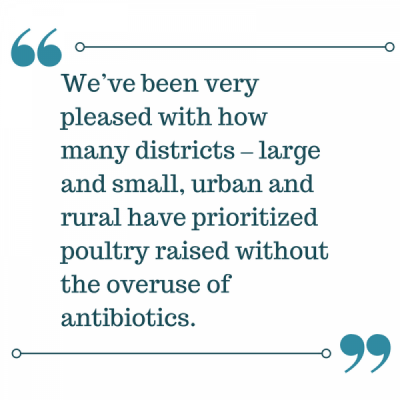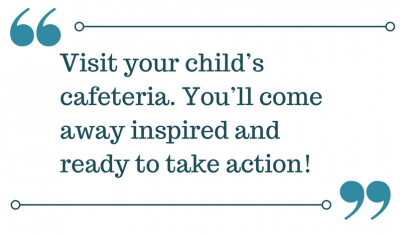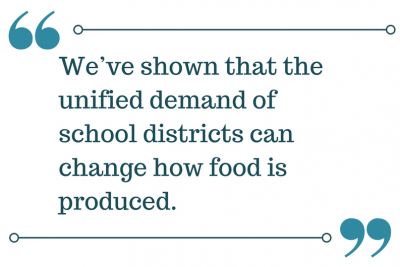Expert Spotlight: Five Questions with Kathy Lawrence, School Food Focus
You vote with your fork, right? But what about with your spork? As warnings over antibiotic resistance become increasingly dire, it’s more important than ever for consumers to support farmers and ranchers who raise their livestock without antibiotic overuse. While buying meat for your own dinner table is certainly important, to truly tackle the problem we need to scale up, and one growing market for responsibly sourced protein is school procurement.
Schools serve millions of meals every day and spend billions of dollars on food annually. Dedicating just a fraction of those budgets to meat raised without antibiotic overuse can add up to significant progress in protecting public health. This is a fact that Kathy Lawrence is well aware of and discusses in our Five Questions interview below from 2015, when she served as Co-Founder and Senior Director of the School Food Focus (no longer an independent non-profit organization).
1. There are many challenges surrounding school food. Why did School Food Focus prioritize getting chicken raised without antibiotic overuse into school cafeterias?
Schools spend $1 billion dollars every year just on poultry. It’s essential that we use these dollars wisely to purchase poultry that supports public and environmental health — from farm to fork. Back in 2008, Focus staff and member school districts first prioritized our deep concern about school food chicken, from antibiotic use practices on the farm to the highly processed chicken products that dominated school lunches. We committed to working together for better poultry on many fronts.
We created the Certified Responsible Antibiotic Use (CRAU) standard with the ultimate goals of replacing conventionally produced poultry and making chicken products that are healthier for children and the planet available to every school in America. CRAU eliminates the overuse of medically important antibiotics and provides an essential level of transparency and accountability lacking in the school food market. It is a first step in transforming the way poultry is produced in this country, laying a solid foundation for responsible production practices.
We’ve been very pleased with how many districts – large and small, urban and rural have prioritized poultry raised without the overuse of antibiotics, and by the response from poultry companies who’ve taken on the challenge of responsible antibiotic use.
2. It was recently announced that School Food Focus was launching an ambitious project with schools and hospitals across California. How did this joint effort come to pass?
Yes, we are thrilled to launch ProCureWorks, our new recipe for human and environmental health! School Food Focus and Health Care Without Harm want to demonstrate how procurement power can transform supply chains across California and nationwide.
Schools and hospitals are major purchasers of healthy food and serve as anchor institutions in their communities. Both hold significant investments in real estate and social capital, and are oriented toward community health goals. The response has been amazing and we are optimistic about the impact this cross sector collaboration will have on regional and national supply chains.
3. What are three tips for how parents can work with their local schools to serve more nutritious and responsibly sourced food?
- Encourage your district to use our Ingredient Guide for Better School Food Purchasing. Our school food leaders have found it invaluable in working with school food suppliers to produce healthier foods for the kids they serve.
- Check out Focus on the Plate, it’s a growing list of over 60 healthy school food products we’ve helped develop or reformulate. All are available for purchase in the school food market.
- Visit your child’s cafeteria. You’ll come away inspired and ready to take action!
4. You’ve been working to fix the U.S. food system for 25 years. How has the movement changed during that time?
It is inspiring to watch the food movement grow and inspire a new generation of enlightened eaters. When I first got started, basic issues like the connection between agriculture and food or food and nutrition were not being made, and the idea of promoting regional, sustainable agriculture and food justice for all were a really tough sell.
There is still a tremendous amount of work to do, to shift our thinking and our food systems in the direction of producing public health and wellbeing for people and the planet. But, the sheer number of people paying attention, getting active and making their voices heard is encouraging. So is the growing commitment to the deep truth that building a sustainable and equitable food system oriented toward providing good food for all requires that the people and communities most affected by the food system’s problems be at the forefront of the work.
5. Can you discuss institutional procurement’s role in creating a more equitable food system?
More than 31 million children rely on public school meals for their daily nutrition. For many, school meals are their only source of healthy food. Yet, our school food systems are significantly under-resourced and far too dependent on highly processed, cheap food. Through our schools we have an opportunity to give these children healthy, good foods and potentially access to a healthier, happier life.
School Food Focus has the privilege of working with some of the most passionate, knowledge and effective school nutrition leaders in the country. Their commitment to providing better food to their kids is nothing short of awe-inspiring. Together, we have proven that school food leaders are major food systems change agents. We’ve shown that the unified demand of school districts can change how food is produced, processed, and served in schools. The vision of these dedicated leaders – and the increasing willingness of the food industry to contribute to that vision – keeps Focus committed to positive, large-scale change.
We believe all children deserve better school food now and more just and equitable food systems in the future. Working with allies across the board to boost the combined purchasing power of large public institutions (schools, hospital, colleges and universities, municipalities, etc) is a critical and effective lever for that change.





